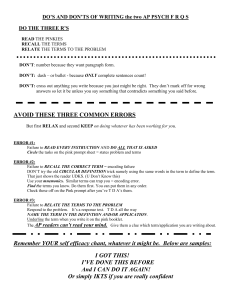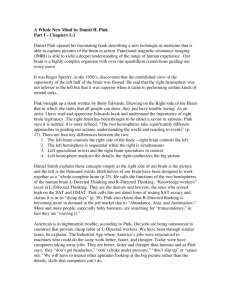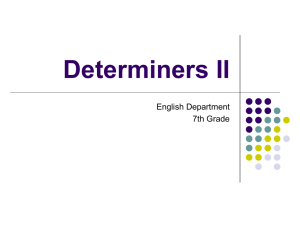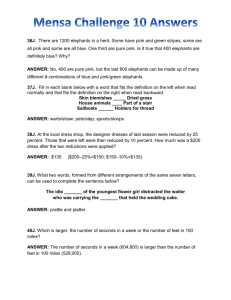File
advertisement
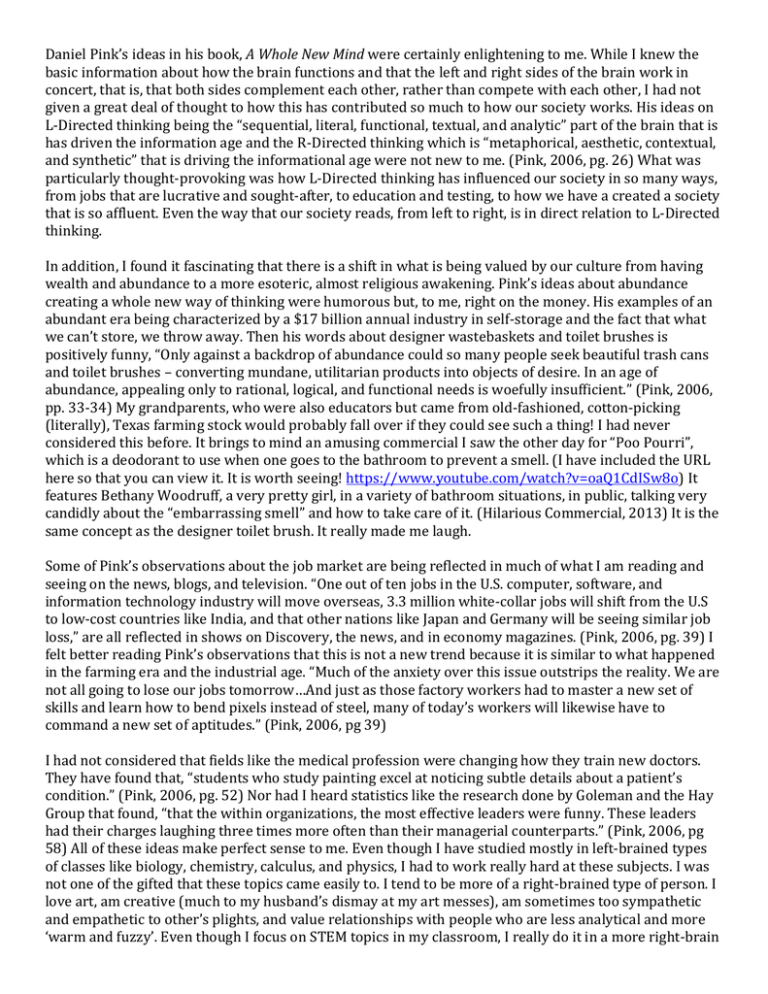
Daniel Pink’s ideas in his book, A Whole New Mind were certainly enlightening to me. While I knew the basic information about how the brain functions and that the left and right sides of the brain work in concert, that is, that both sides complement each other, rather than compete with each other, I had not given a great deal of thought to how this has contributed so much to how our society works. His ideas on L-Directed thinking being the “sequential, literal, functional, textual, and analytic” part of the brain that is has driven the information age and the R-Directed thinking which is “metaphorical, aesthetic, contextual, and synthetic” that is driving the informational age were not new to me. (Pink, 2006, pg. 26) What was particularly thought-provoking was how L-Directed thinking has influenced our society in so many ways, from jobs that are lucrative and sought-after, to education and testing, to how we have a created a society that is so affluent. Even the way that our society reads, from left to right, is in direct relation to L-Directed thinking. In addition, I found it fascinating that there is a shift in what is being valued by our culture from having wealth and abundance to a more esoteric, almost religious awakening. Pink’s ideas about abundance creating a whole new way of thinking were humorous but, to me, right on the money. His examples of an abundant era being characterized by a $17 billion annual industry in self-storage and the fact that what we can’t store, we throw away. Then his words about designer wastebaskets and toilet brushes is positively funny, “Only against a backdrop of abundance could so many people seek beautiful trash cans and toilet brushes – converting mundane, utilitarian products into objects of desire. In an age of abundance, appealing only to rational, logical, and functional needs is woefully insufficient.” (Pink, 2006, pp. 33-34) My grandparents, who were also educators but came from old-fashioned, cotton-picking (literally), Texas farming stock would probably fall over if they could see such a thing! I had never considered this before. It brings to mind an amusing commercial I saw the other day for “Poo Pourri”, which is a deodorant to use when one goes to the bathroom to prevent a smell. (I have included the URL here so that you can view it. It is worth seeing! https://www.youtube.com/watch?v=oaQ1CdISw8o) It features Bethany Woodruff, a very pretty girl, in a variety of bathroom situations, in public, talking very candidly about the “embarrassing smell” and how to take care of it. (Hilarious Commercial, 2013) It is the same concept as the designer toilet brush. It really made me laugh. Some of Pink’s observations about the job market are being reflected in much of what I am reading and seeing on the news, blogs, and television. “One out of ten jobs in the U.S. computer, software, and information technology industry will move overseas, 3.3 million white-collar jobs will shift from the U.S to low-cost countries like India, and that other nations like Japan and Germany will be seeing similar job loss,” are all reflected in shows on Discovery, the news, and in economy magazines. (Pink, 2006, pg. 39) I felt better reading Pink’s observations that this is not a new trend because it is similar to what happened in the farming era and the industrial age. “Much of the anxiety over this issue outstrips the reality. We are not all going to lose our jobs tomorrow…And just as those factory workers had to master a new set of skills and learn how to bend pixels instead of steel, many of today’s workers will likewise have to command a new set of aptitudes.” (Pink, 2006, pg 39) I had not considered that fields like the medical profession were changing how they train new doctors. They have found that, “students who study painting excel at noticing subtle details about a patient’s condition.” (Pink, 2006, pg. 52) Nor had I heard statistics like the research done by Goleman and the Hay Group that found, “that the within organizations, the most effective leaders were funny. These leaders had their charges laughing three times more often than their managerial counterparts.” (Pink, 2006, pg 58) All of these ideas make perfect sense to me. Even though I have studied mostly in left-brained types of classes like biology, chemistry, calculus, and physics, I had to work really hard at these subjects. I was not one of the gifted that these topics came easily to. I tend to be more of a right-brained type of person. I love art, am creative (much to my husband’s dismay at my art messes), am sometimes too sympathetic and empathetic to other’s plights, and value relationships with people who are less analytical and more ‘warm and fuzzy’. Even though I focus on STEM topics in my classroom, I really do it in a more right-brain type of atmosphere that I really didn’t realize I used (at least not in a conscious way) until I started reading this book. Sources: Pink, D. H. (2006). A whole new mind: why right-brainers will rule the future. New York: Riverhead Books. HILARIOUS REAL Commercial: Poo-Pourri with BETHANY WOODRUFF. (2013, September 10). YouTube. Retrieved May 10, 2014, from https://www.youtube.com/watch?v=oaQ1CdISw8o
